We are in month 2 of my “write a post daily” medical SEO experiment. A new website, unlinked in my network, which should grow organically by posting and backlinks over the year.
Until the SEO experiment is finished, its identity is hidden.
Let’s see how our reports look like and the main plan for this month:
Table of Contents
Case Study Month By Month
March 2023 – Rankings and Traffic after 1 Month
I bet you all want to see our initial results and, most importantly, how I plan to get more growth in March.
I am using a mix of Ahrefs, Google Search Console and a Looker Studio template that allow me to view data from all possible angles and also prioritize optimization.
If I spent the first month posting content based on “easy win” keywords and some pillar topics, March means I can re-optimize the content that doesn’t move up as fast as I’d like it to.
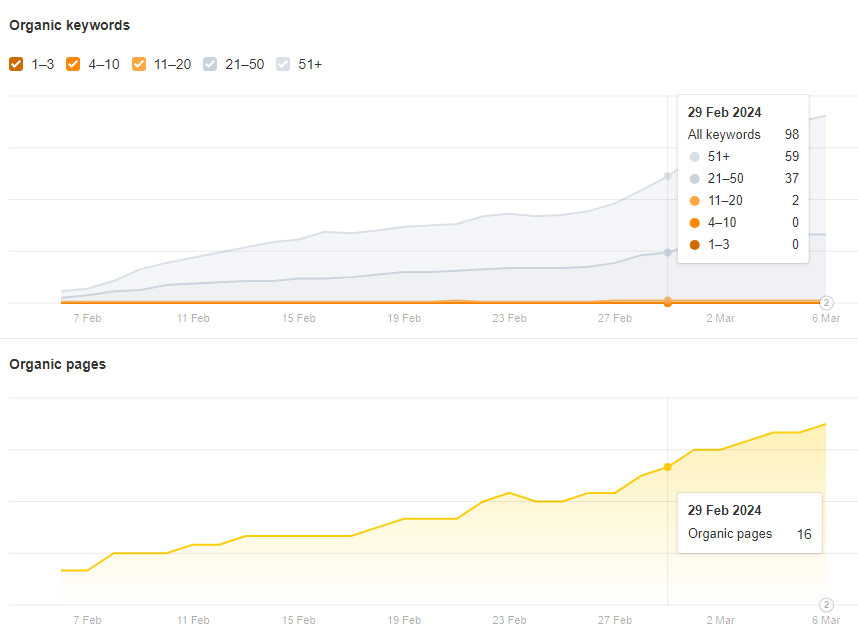
Compared to the 3-weeks ranking situation, we are clearly moving forward. I have stopped my “counter” for February 29, but you can already see improvement past this date.
I let data “sit” for almost 1 week, so that we get Google Search Console to properly index all content (which was already published) and give us some clear data (they are usually late 2-3 days at least).
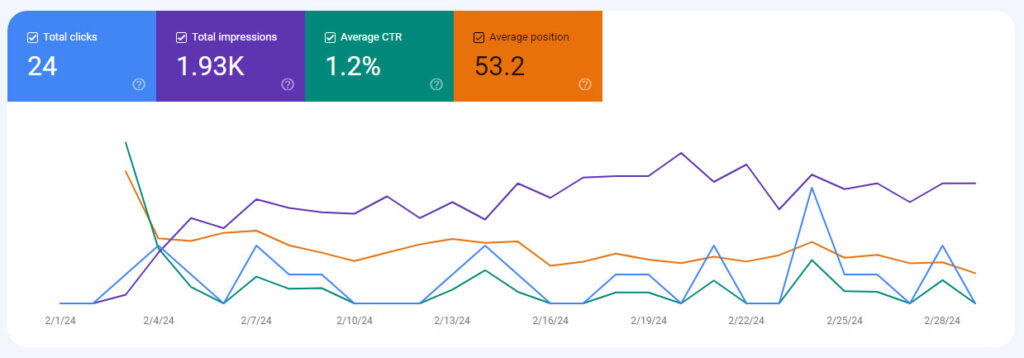
This is the GSC data from February 1st to February 29. How do we read into this?
- 24 clicks – not ideal for 29 days, averaging less than 1 day, but we should see an improvement in March. Let’s not forget that SEO is not instant and it usually needs 3-6 months at least to kick in.
- 1.93K impressions – this is where the money is for a new website. As it settles down in the SERPs, a website’s progress in the first months is easy to see through impressions. This means that you are getting ranked (even if in low positions) for more keywords every day and, based on this, you can easily improve towards top 5 placement;
- 1.2% CTR – VERY LOW (we try to aim to at least 5%), but absolutely normal for the average position we have;
- 53.2 average position – not too sexy, but, again consistent with the content velocity we have and the website’s age.
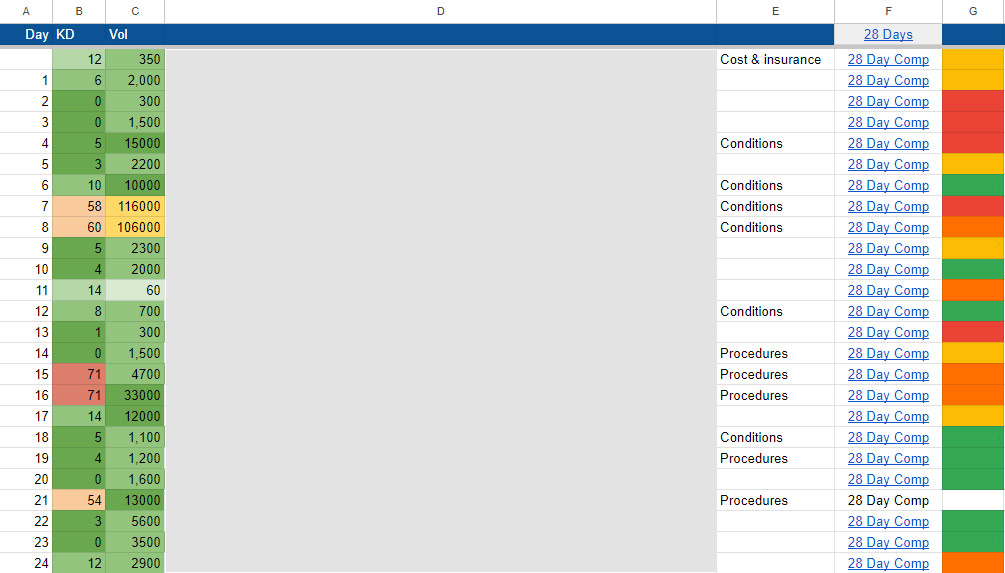
I started a new sheet for March but also tweaked my February reporting.
The green sections show that the pages are going up, the yellow ones are not as fast as I’d like them to do, while the orange and red ones are getting lower rankings or “spotty indexation”.
Why are rankings fluctuating like this?
- the website is still brand new, so Google is trying to assess its value compared to the other websites ranked;
- some articles just need improvements. I don’t claim to write the best content ever, so constantly reviewing my stats is the way to PRIORITIZE SEO work every month. I don’t just write blindly, I build my topical map and constantly look for gaps I can fill.
- my competitors are not sleeping. I’m not the only one doing medical SEO here, so I expect others to bring in their A-game.
- we are going through monthly Google algorithm updates, which sometimes affect us negatively.
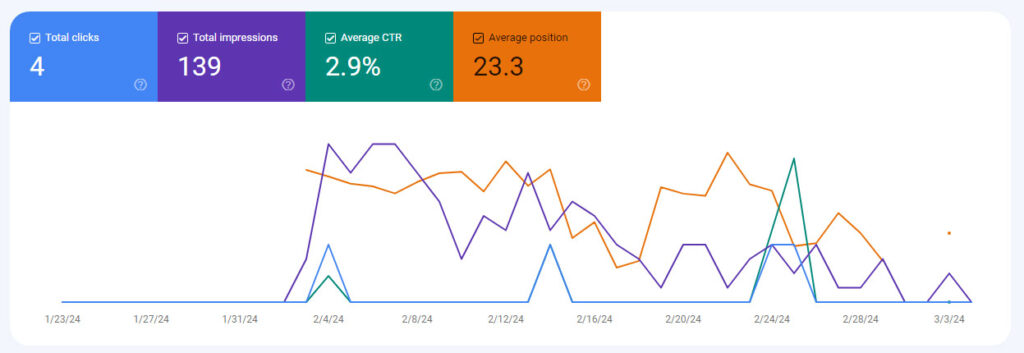
This is a page that might need my attention.
Since it’s still new, rankings can easily change for the better, especially with not such a bad initial ranking and a CTR bigger that the website’s average.
Let’s use it for a quick audit though, to find out how we ‘read’ this GSC data:
- If my CTR is not at least 5%, it means I need to improve the way this page shows in the Google Search results. Better title and meta description (to entice people to click). Based on current rankings, just improving your titles and metas can already get more traffic. It’s a quick win!
- If the average position is way lower, just improving the title and meta description won’t solve too much. It’s good to have them perfect, but in this case we just need to move the page UP in the SERPs.
- I’ll also look at the other keywords this page ranks for, it will show me new potential articles or just extra information I can add. If I get impressions for them, people are clearly searching for that, so it makes sense to improve the article with extra research.
During my performance assessment, I’m looking at my top pages and see if there are any patterns (I get easy keywords to rank, I rank because I have written 3-4 articles on a common keyword cluster etc.)
What New Content Will I Write in March
With my “daily article” plan in mind, I have the following options for tackling new posts:
- keywords that my competitors rank for in top positions – if other small DR websites can do it, there’s no reason for me to fail;
- keywords with low difficulty – it’s still a small website, my efforts should go into content that I can get on top positions;
- keywords that appear in my ranking data and have enough volume to be worth their own articles;
- other sub-topics from my topical map, so that I can cover my chosen niche as fully as possible. The more I cover a certain cluster, the more interlinking options I get and overall better rankings.
I will continue my posting streak, indexation requests, and ranking tracking, just as I did in the past month. At the same time, I’ll start re-optimizing the pages that are not ranking top 10 yet or seem too volatile in the SERPs.
What Is My System of Recognizing Pages to Optimize?
One question I get from all of my SEO audit clients is: OK, what do we do now?
In most cases we don’t have the manpower to optimize all the pages at once, while also writing content, doing outreach etc. So we need to PRIORITIZE.
This is probably my favorite word right now.
How to prioritize which pages need updates?
- looking at my stats, I’ll see if I have any pages ranking on positions 11-20. If they are on page 2, it means there’s something about them to still get a pretty decent ranking, so maybe a little more love will get them in top 10 (ideally even higher);
- keywords with low difficulty and bigger volumes, that are already trending up. If I get in top 5 with a keyword that has 10,000 monthly searches, I’ll do better than if I rank in the same place with one that gets 30 searches. The caveat is that, as a brand new website, I’ll need to settle with some small volume keywords as well, until I get some traction and can tackle the more valuable ones.
- high CPC keywords. Soon we’ll try to get the website into Adsense and, while their payout is dismal, it’s good to have an Adsense approved website in order to get into better ad networks or sell. With this in mind, I’ll try to rank high for expensive keywords, as this will allow us to earn more money.
- keywords that are part of my topical map and seem to boost a certain cluster. If I see an uptick in my traffic based on “gestational diabetes” (as one keyword used as an example), I’ll write more around it, so that it ranks higher and it also pushes secondary keywords into the SERPs. This goes nicely with the topical authority strategy we employ.
- keywords that have a solid increase in rankings: 20+ positions. If they took such a leap in a very short amount of time, it means Google likes what we are doing and there are chances to get faster growth.
How to Optimize Underperforming Pages
On my new ranking stats I have noticed a few articles that are struggling to rank better. I opened them one by one and also the main competitors for each keyword.
Is my page worthy of 1st position? Have I published the best possible article on [insert topic]?
While Google still ranks a lot of crappy websites, at least a few of the top-ranking pages are BETTER than mine. Not an easy pill to swallow by a perfectionist, but I’d rather have a clear explanation than just say “Well, who knows?”
Enter NeuronWriter.
I recently purchased a lifetime license for NeuronWriter, after wasting money on GetGenie. That was a complete bust, the app claims to be another Surfer SEO, but it’s by far the worst I have worked with.
Surfer is a tad too expensive (if you also combine the SEO optimization part) and Frase gets expensive if you pay monthly, although my favorite by a mile.
With a lifetime license that cost me 4 months of Frase, I decided to switch to NeuronWriter which is .. so-so. Not too intuitive or pretty, but it still does a decent job of giving me some insights to improve my rankings.
Here is a snapshot of the optimization score I have for one of my “ailing” articles.

Disclaimer: you don’t need to go crazy with optimization scores, but there is a lot to improve.
- Increase word-count. Long gone are the days when you’d write 500 words and call it a day. If most of the top rankers have over 1,500 words, you won’t easily rank with 500. Consequently, if most competitors have ranked with a smaller word count, you can delete useless info and reduce the number of words.
- Add missing headings. I look at all the information presented by competitors and add the headings and sub-headings I missed. For each I’ll write some additional content.
- Tweak the content based on the NLP (Natural Language Processing) terms found in competing pages. If I have overused a term, I can now find synonyms and give the content a better flow.
- Add more images, infographics, and videos, if possible.
- Create more internal links and, if applicable, get backlinks to the stubborn article.
Start Acquiring Some Backlinks
Developing a website without getting some backlinks is possible, but I don’t see any reasons to prevent my project from getting an additional boost, if possible.
Again, I’m trying to use strategies that anyone can use (so no, getting links from huge DR websites is not easy, unless you are a big PR agency).
What would anyone do, as soon as they released a new website? Probably do a press release.
Press Release
A press release is a good way for your new website to get some initial links. Mind you, most of them are not huge DR or exceptional quality, but they are backlinks and, if used properly, will allow the website to get a little boost.
For this, I used our service, SEO Amplifier Press Release and Syndication Service and created a story about the new website.
Nothing too fancy, as we’re not hitting the first page on USA Today, but presenting the new website, what we try to achieve with it, and a few words about the founder.
I have placed 2 links: one to the main page and one for the blog section.
-
SEO Amplifier Press Release and Syndication Service
Original price was: $500.00.$250.00Current price is: $250.00.
Do NOT use such a service for optimized anchors (those that are supposed to improve rankings on certain content pages), a press release is not suitable for that.
Getting 300 links with the anchor “how to floss with Invisalign“, for instance, won’t sit well with Google’s gods, so don’t even go there.
—
This is the overall plan for March. I’ll resume my posting and optimization efforts, then show you the results in about a month’s time.
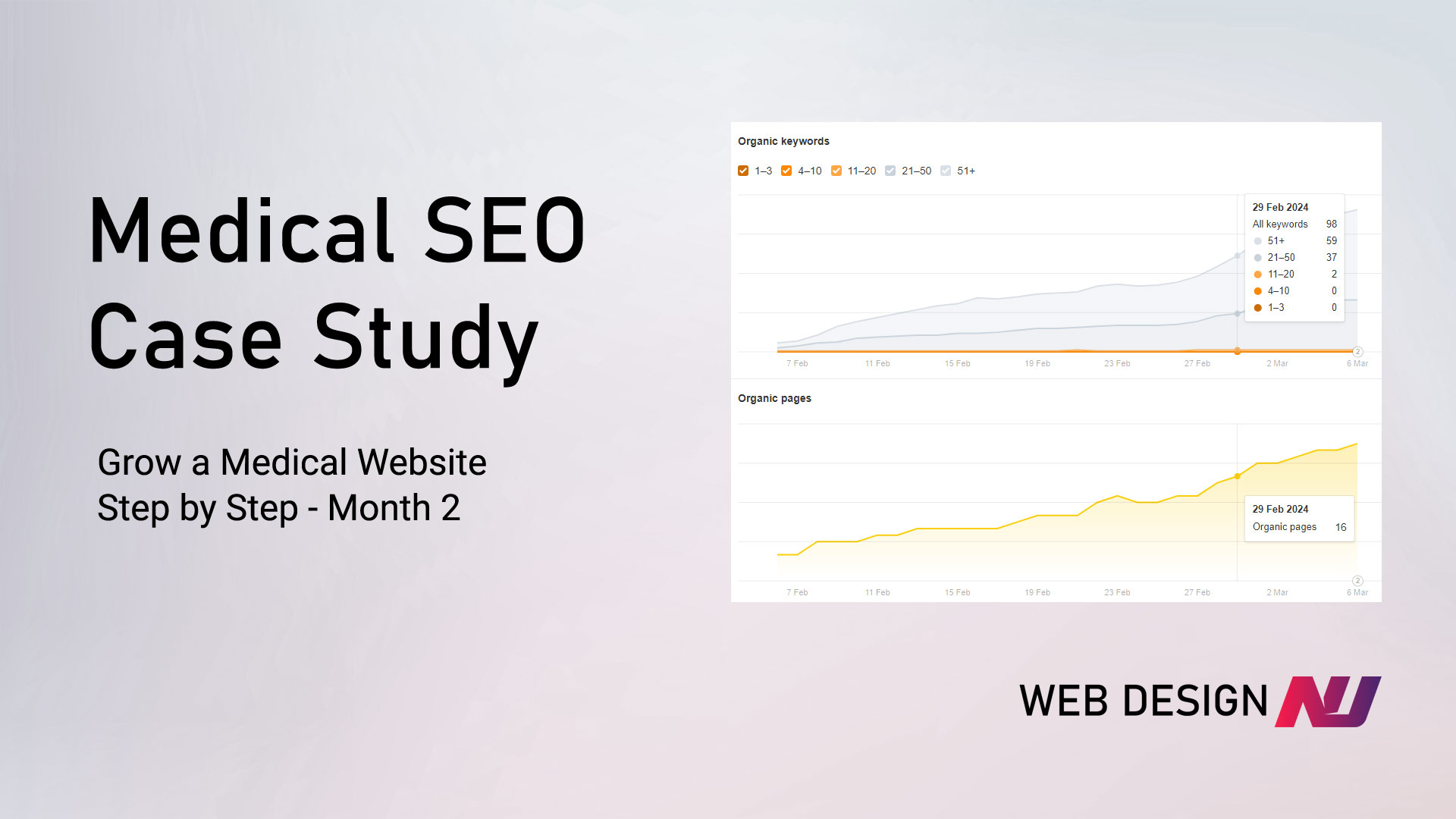


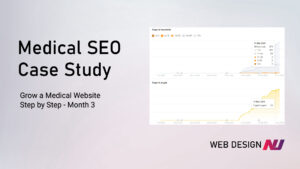
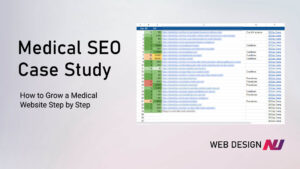

[…] Medical SEO Case Study – Month 2 […]